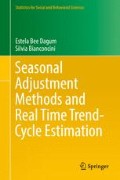Abstract
The linear filter developed by Henderson is the most widely applied to estimate the trend-cycle component in seasonal adjustment software such as the US Bureau of Census II-X11 and its variants, the X11/X12ARIMA. Major studies have been done on trend-cycle estimation during the last 20 years by making changes to the Henderson filters. The emphasis has been on determining the direction of the short-term trend for an early detection of a true turning point. This chapter introduces in detail three major contributions: (1) a nonlinear trend-cycle estimator also known as Nonlinear Dagum Filter (NLDF), (2) a Cascade Linear Filter (CLF) that closely approximates the NLDF, and (3) an approximation to the Henderson filter via the Reproducing Kernel Hilbert Space (RKHS) methodology.
Access this chapter
Tax calculation will be finalised at checkout
Purchases are for personal use only
References
Berlinet, A. (1993). Hierarchies of higher order kernels. Probability Theory and Related Fields, 94, 489–504.
Berlinet, A., & Devroye, L. (1994). A comparison of kernel density estimates. Publications de l’Institut de Statistique de l’Université de Paris, 38, 3–59.
Box, G. E. P., & Jenkins, G. M. (1970). Time series analysis: Forecasting and control. San Francisco, CA, USA: Holden-Day (Second Edition 1976).
Castles, I. (1987). A guide to smoothing time series estimates of trend. Catalogue No. 1316. Australian Bureau.
Chhab, N., Morry, M., & Dagum, E. B. (1999). Results on alternative trend-cycle estimators for current economic analysis. Estadistica, 49–51, 231–257.
Cholette, P. A. (1981). A comparison of various trend-cycle estimators. In O. D. Anderson & M. R. Perryman (Eds.), Time series analysis (pp. 77–87). Amsterdam: North Holland.
Cleveland, R. B., Cleveland, W. S., McRae, J. E., & Terpenning, I. (1990). STL: A seasonal trend decomposition procedure based on LOESS. Journal of Official Statistics, 6(1), 3–33.
Dagum, E. B. (1988). The X11ARIMA/88 seasonal adjustment method-foundations and user’s manual. Ottawa, Canada: Time Series Research and Analysis Centre, Statistics Canada.
Dagum, E. B. (1996). A new method to reduce unwanted ripples and revisions in trend-cycle estimates from X11ARIMA. Survey Methodology, 22, 77–83.
Dagum, E. B., & Bianconcini, S. (2006). Local polynomial trend-cycle predictors in reproducing kernel Hilbert spaces for current economic analysis. Anales de Economia Aplicada, 1–22.
Dagum, E. B., & Bianconcini, S. (2008). The Henderson smoother in reproducing kernel Hilbert space. Journal of Business and Economic Statistics, 26(4), 536–545.
Dagum, E. B., Chhab, N., & Chiu, K. (1996). Derivation and analysis of the X11ARIMA and Census X11 linear filters. Journal of Official Statistics, 12(4), 329–347.
Dagum, E. B., & Laniel, N. (1987). Revisions of trend-cycle estimators of moving average seasonal adjustment methods. Journal of Business and Economic Statistics, 5, 177–189.
Dagum, E. B., & Luati, A. (2000). Predictive performance of some nonparametric linear and nonlinear smoothers for noisy data. Statistica, LX(4), 635–654.
Dagum, E. B., & Luati, A. (2004). A linear transformation and its properties with special applications in time series filtering. Linear Algebra and its Applications, 338, 107–117.
Dagum, E. B., & Luati, A. (2009). A cascade linear filter to reduce revisions and turning points for real time trend-cycle estimation. Econometric Reviews, 28(1–3), 40–59.
Dalton, P., & Keogh, G. (2000). An experimental indicator to forecast turning points in the Irish business cycle. Journal of the Statistical and Social Inquiry Society of Ireland, XXIX, 117–176.
Darnè, O. (2002). La dèsaisonnalisation des chroniques économiques: analyse des conditions conjuncturelles (Ph.D. dissertation, Department of Economics, University of Montpellier 1, France).
Findley, D. F., & Martin, D. E. K. (2006). Frequency domain analysis of SEATS and X-11/X-12-ARIMA seasonal adjustment filters for short and moderate length time series. Journal of Official Statistics, 22, 1–34.
Findley, D. F., Monsell, B. C., Bell, W. R., Otto, M. C., & Chen, B. C. (1998). New capabilities and methods of the X12ARIMA seasonal adjustment program. Journal of Business and Economic Statistics, 16(2), 127–152.
Gray, A., & Thomson, P. (1996). Design of moving-average trend filters using fidelity and smoothness criteria. In P. M. Robinson & M. Rosenblatt (Eds.), Time series analysis (in memory of E.J. Hannan). Vol. II. Lecture notes in statistics (Vol. 115, pp. 205–219). New York: Springer.
Henderson, R. (1916). Note on graduation by adjusted average. Transaction of Actuarial Society of America, 17, 43–48.
Kenny, P., & Durbin, J. (1982). Local trend estimation and seasonal adjustment of economic and social time series. Journal of the Royal Statistical Society A, 145, 1–41.
Ladiray, D., & Quenneville, B. (2001). Seasonal adjustment with the X-11 method. Lecture notes in statistics (Vol. 158). New York: Springer.
Loader, C. (1999). Local regression and likelihood. New York: Springer.
Müller, H. G. (1984). Smooth optimum kernel estimators of regression curves, densities and modes. Annals of Statistics, 12, 766–774.
Musgrave, J. (1964). A set of end weights to end all end weights. Working Paper. U.S. Bureau of Census, Washington DC.
Priestley, M. B. (1981). Spectral analysis and time series. Probability and mathematical statistics. New York: Academic Press.
Quenneville, B., Ladiray, D., & Lefrancois, B. (2003). A note on Musgrave asymmetrical trend-cycle filters. International Journal of Forecasting, 19(4), 727–734.
Shiskin, J., Young, A. H., & Musgrave, J. C. (1967). The X-11 variant of the Census Method II seasonal adjustment program. Technical Paper 15 (revised). US Department of Commerce, Bureau of the Census, Washington, DC.
Wahba, G. (1990). Spline models for observational data. Philadelphia: SIAM.
Zellner, A., Hong, C., & Min, C. (1991). Forecasting turning points in international output growth rates using Bayesian exponentially weighted autoregression, time-varying parameter and pooling techniques. Journal of Econometrics, 48, 275–304.
Author information
Authors and Affiliations
Rights and permissions
Copyright information
© 2016 Springer International Publishing Switzerland
About this chapter
Cite this chapter
Bee Dagum, E., Bianconcini, S. (2016). Further Developments on the Henderson Trend-Cycle Filter. In: Seasonal Adjustment Methods and Real Time Trend-Cycle Estimation. Statistics for Social and Behavioral Sciences. Springer, Cham. https://doi.org/10.1007/978-3-319-31822-6_8
Download citation
DOI: https://doi.org/10.1007/978-3-319-31822-6_8
Published:
Publisher Name: Springer, Cham
Print ISBN: 978-3-319-31820-2
Online ISBN: 978-3-319-31822-6
eBook Packages: Mathematics and StatisticsMathematics and Statistics (R0)

